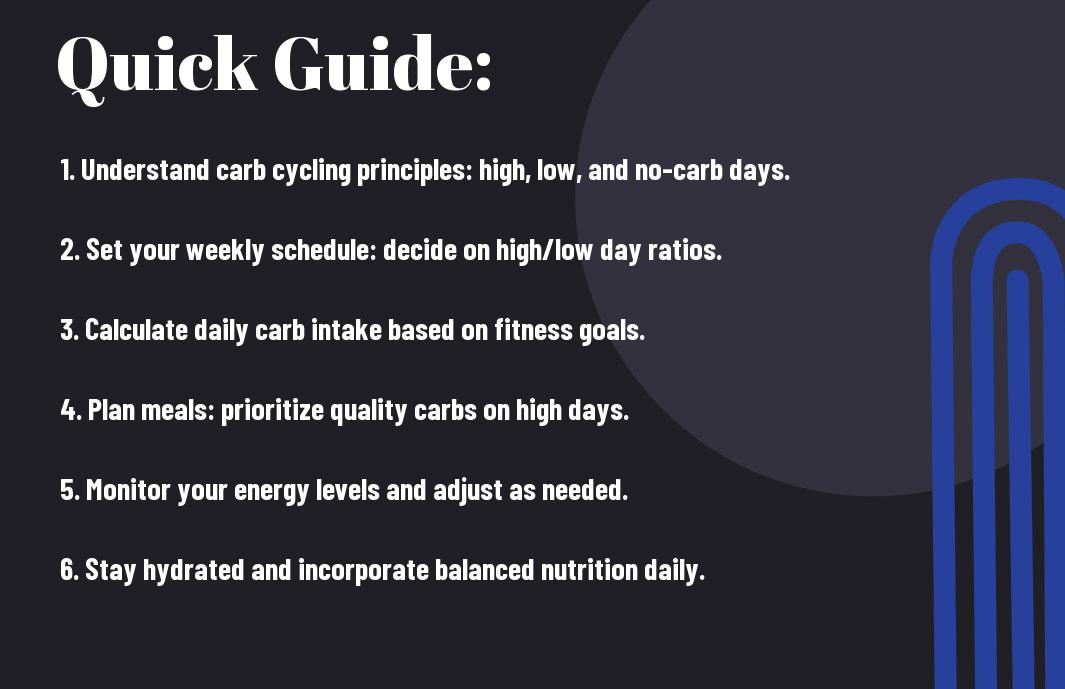This guide is designed to introduce you to carb cycling, a flexible nutrition strategy that can help you optimize your performance and reach your fitness goals. You’ll learn how to effectively alternate between high-carb and low-carb days, helping your body maximize energy and burn fat. This straightforward approach can be tailored to fit your lifestyle, making it easier for you to adopt and maintain. Dive into this simple guide to unlock the benefits of carb cycling and enhance your overall nutrition journey.
Key Takeaways:
- Carb Cycling: This approach alternates between high-carb and low-carb days to optimize fat loss and muscle gain.
- High-Carb Days: Designed to boost energy levels and replenish glycogen stores, these days are generally scheduled around intense workout sessions.
- Low-Carb Days: Aimed at promoting fat burning, these days require reduced carbohydrate intake to encourage the body to use fat as fuel.
- Tracking Intake: Monitoring both carbs and overall calories is necessary for effective carb cycling. Use food diaries or apps for accurate tracking.
- Macronutrient Balance: Besides carbs, pay attention to protein and fat consumption to ensure a balanced diet that supports your fitness goals.
- Adaptability: It’s important to customize the carb cycling plan according to individual needs, preferences, and response to the diet.
- Consult Professionals: Before starting any new diet plan, consulting with a nutritionist or dietitian can provide tailored advice and ensure a safe approach.
Understanding Carb Cycling
While carb cycling may sound complex, it necessaryly involves alternating between high and low carbohydrate intake to optimize your body’s nutrient use. This method can enhance fat loss while preserving muscle, making it a popular choice for many fitness enthusiasts. By manipulating carbs in your diet, you can improve energy levels on intense training days and promote fat burning on rest days, supporting your overall fitness goals.
What is Carb Cycling?
Little understood by many, carb cycling is a dietary approach that focuses on varying your carbohydrate intake throughout the week. The primary aim is to utilize higher carb days to fuel workouts while incorporating lower carb days to encourage fat loss. This method allows you to enjoy more flexibility in your diet without constant restrictions, ultimately helping you achieve a more balanced nutritional profile.
Types of Carb Cycling
What distinguishes carb cycling are the various types tailored to fit your specific fitness goals and preferences. Each type provides a different structure, allowing for flexibility in your eating plan. Here are some popular variations:
| Type | Description |
| Standard Carb Cycling | Alternates between high and low carb days during the week. |
| Targeted Carb Cycling | Involves consuming carbs just before or after workouts only. |
| Cyclical Ketogenic Diet | A mix of high-fat, low-carb days followed by a high-carb refeed. |
| Low-Carb Days | Generally consists of two to six days with minimal carb intake. |
| High-Carb Days | Typically includes one to two days of increased carb consumption. |
- Choose the type that best aligns with your fitness objectives.
- Adjust based on your individual responses throughout the cycling process.
- Monitor your energy levels on both high and low-carb days.
- Stay consistent for optimal results.
- Thou should tailor your approach for maximum effectiveness.
Cycling through different types allows you to adapt your carb intake based on your weekly training schedule and personal needs. By understanding how each variation works, you can better tailor your diet to achieve significant results. Here’s a detailed breakdown of various types:
| Type | Best For |
| Standard Carb Cycling | General fat loss and muscle preservation. |
| Targeted Carb Cycling | Endurance athletes seeking performance optimization. |
| Cyclical Ketogenic Diet | Those wanting to incorporate ketosis with carb cycling. |
| Low-Carb Days | Individuals looking for a more restrictive approach. |
| High-Carb Days | Athletes needing explosive energy for workouts. |
- Evaluate how each type aligns with your lifestyle and goals.
- Consider training intensity and response when deciding on cycles.
- Track your progress for necessary adjustments.
- Stay hydrated throughout your carb cycling journey.
- Thou should analyze and refine your approach over time.


Step-by-Step Guide to Carb Cycling
You can enhance your nutrition strategy through carb cycling. This process involves alternating between high-carb and low-carb days to optimize fat burning while maintaining muscle mass. For more on Carb cycling: Benefits, evidence, and how to do it, follow these steps:
| Description | |
| 1. Determine Your Caloric Needs | Calculate your daily energy expenditure based on activity levels. |
| 2. Set Carb Cycling Patterns | Decide on high-carb and low-carb days tailored to your lifestyle. |
| 3. Plan Your Meals | Create meal plans that fit within your set carb limits. |
| 4. Track Your Progress | Monitor changes in weight and energy to make adjustments. |
Planning Your Carb Intake
Intake planning is important for effective carb cycling. Start by determining your total daily carbohydrate needs based on your fitness goals and body type. Allocate your carbs appropriately between high and low days to fuel workouts while also supporting fat loss. Aim for complex carbohydrates on high-carb days for sustained energy, and focus on protein and healthy fats on low-carb days for better metabolic efficiency.
Sample Weekly Carb Cycling Schedule
With a structured schedule, you can easily follow carb cycling without confusion. An example could consist of three high-carb days followed by four low-carb days. High-carb days are best placed before intense workouts for optimal energy, while low-carb days allow your body to tap into fat stores for fuel.
A well-planned schedule could look like this: Monday (High), Tuesday (Low), Wednesday (High), Thursday (Low), Friday (Low), Saturday (High), Sunday (Low). This balance will help ensure you have the energy to perform while still creating an effective fat loss environment.

Tips for Successful Carb Cycling
Once again, for effective carb cycling, consider the following tips to enhance your experience:
- Plan your carb intake around workouts.
- Combine high-carb days with intense training.
- Stay hydrated and consider electrolytes.
- Focus on whole, nutrient-dense foods.
Any adjustments you make should align with your specific fitness goals and lifestyle. For more details, check out What Is Carb Cycling?.
Meal Preparation Strategies
On your carb cycling journey, meal preparation can simplify your daily routine. Preparing meals in advance allows you to control portions and ensure you’re hitting your macro targets. Consider dedicating one day a week to cook and store meals, making it easier to adhere to your carb cycling plan and avoid unhealthy food choices.
Tracking Your Progress
Assuming you want to see the results of your efforts, tracking your progress is vital. This could involve keeping a food diary or using an app to log your carb intake and workouts. Regularly reviewing this data will help you adjust your plan as needed to achieve optimal results.
Carb cycling can be enhanced by monitoring your body’s response and adjusting based on what works for you. Pay attention to your energy levels, performance in workouts, and how your body composition changes. By analyzing this information, you can fine-tune your carb intake, workout intensity, and overall approach to maximize results.

Factors to Consider Before Starting
Your journey into carb cycling should start by assessing several key factors that can influence your success. These include:
- Your individual fitness goals
- Current dietary habits
- Daily activity levels
- Health conditions or dietary restrictions
Perceiving how these elements align will help create a tailored approach that fits your lifestyle and enhances your results.
Personal Goals and Lifestyle
If you aim to lose weight, build muscle, or simply maintain your current physique, your carb cycling plan should reflect those specific goals. Consider how your daily life, work schedule, and exercise routine can be integrated into a sustainable carb cycling strategy that works for you.
Nutritional Needs and Health Conditions
Assuming you have specific dietary needs or underlying health conditions, it’s necessary to tailor your carb cycling approach accordingly. Consult a healthcare professional or nutritionist to ensure you remain healthy while pursuing your fitness goals.
Nutritional needs vary significantly among individuals. Factors such as age, gender, activity level, and overall health can influence how many carbs you should consume on low and high-carb days. If you have specific conditions like diabetes, it becomes even more important to monitor your carbohydrate intake closely, as this can affect blood sugar levels. A personalized approach ensures that you get the nutrients necessary for optimal performance and health, making it necessary to adequately assess your nutritional needs before starting carb cycling.
Pros and Cons of Carb Cycling
Now, understanding the pros and cons of carb cycling can help you decide if it’s the right approach for you. Below is a summary of the benefits and potential downsides of this diet strategy:
For more insights on carb cycling, check out this article on What Is Carb Cycling — and Should You Try It?
Benefits of Carb Cycling
Clearly, one of the main benefits of carb cycling is its potential to help you lose weight while maintaining muscle mass. By varying your carb intake, you can tailor your diet to align with your physical activity levels, promoting energy when needed and fat loss during less active periods. This approach may also enhance your workout performance, allowing you to maximize your training effects.
Potential Drawbacks
Little attention is often paid to the drawbacks of carb cycling. While it can yield results, you may find it demanding to adhere to, especially if you have a busy lifestyle or limited meal-prepping time. The constant fluctuation in carb intake might also lead to feelings of fatigue or affect your overall mood.
A deeper concern is that carb cycling can lead to nutritional deficiencies if not planned properly. Restricting carbohydrates may deprive you of necessary vitamins and minerals found in whole grains, fruits, and vegetables. Additionally, the complexity of this diet may create stress when trying to balance your macronutrient intake, which could lead to an unhealthy relationship with food. If you’re considering carb cycling, it’s necessary to assess your lifestyle, goals, and whether you can commit to this structured dietary approach.
FAQs on Carb Cycling
Keep your questions in check! Carb cycling can seem complex at first, but many of your concerns will be answered as you explore deeper into the method. You may wonder how often to cycle, what foods to include, or how it affects your workout performance. This section provides clear, concise answers to frequently asked questions to help you navigate your carb cycling journey effectively. Understanding these key aspects will empower you to tailor this approach to your lifestyle and fitness goals.
Conclusion
Presently, you’ve been introduced to the important components of carb cycling, helping you create a flexible plan tailored to your goals. As you navigate through higher and lower carb days, pay attention to how your body responds, adjusting accordingly to optimize energy levels and performance. This simple guide empowers you to take control of your nutrition, enabling you to enjoy the benefits of carb cycling while still indulging in your favorite foods. By staying informed and committed, you can enhance your fitness journey effectively.





